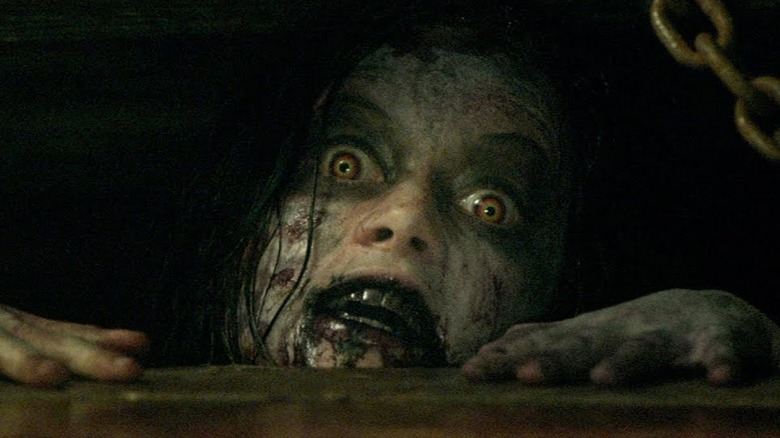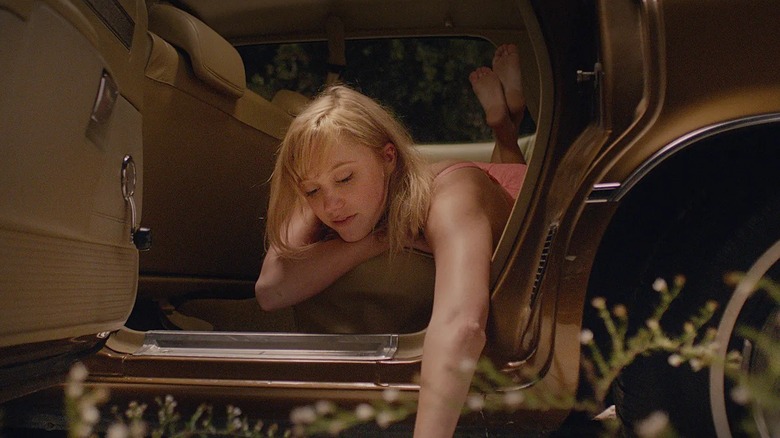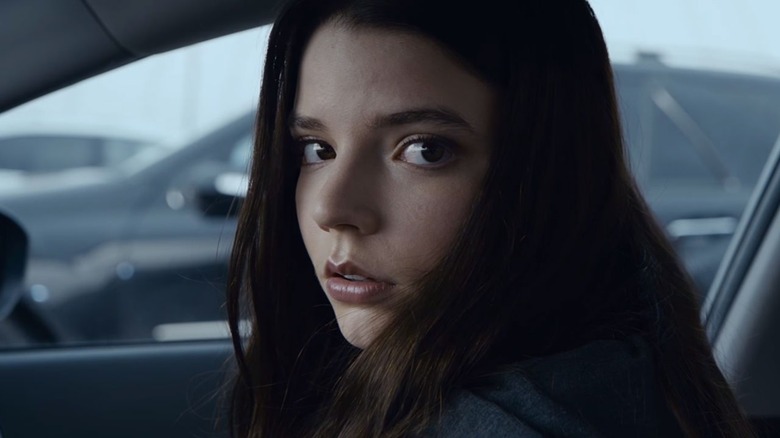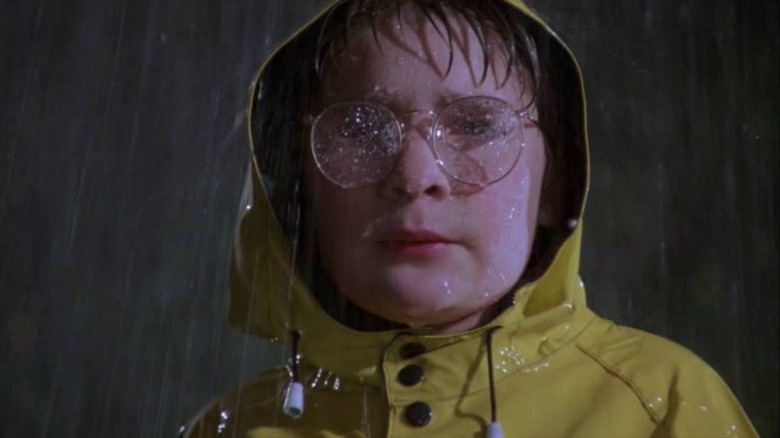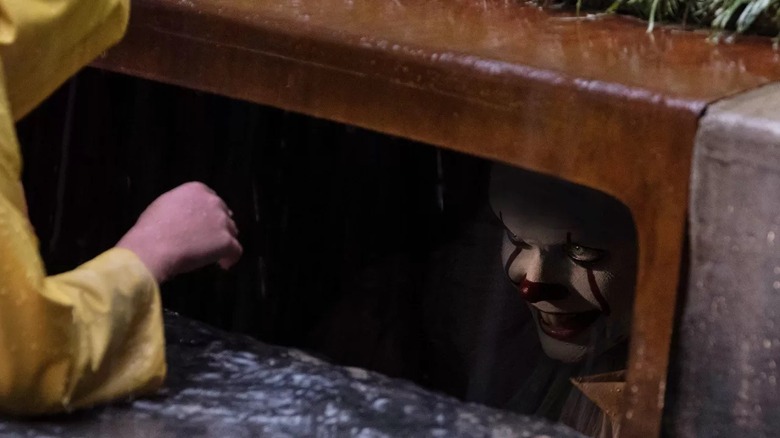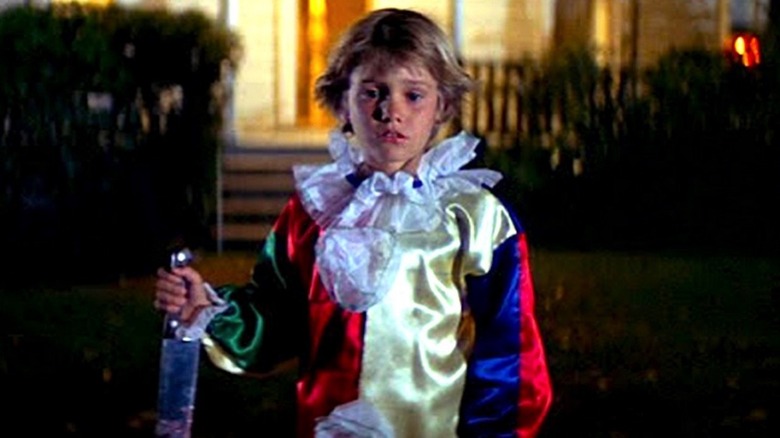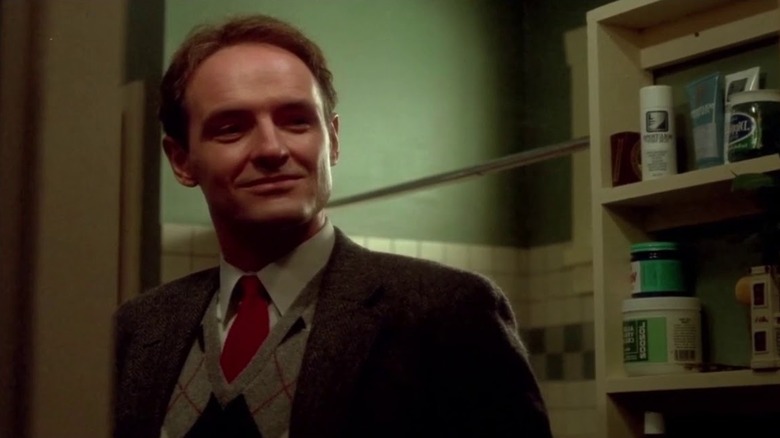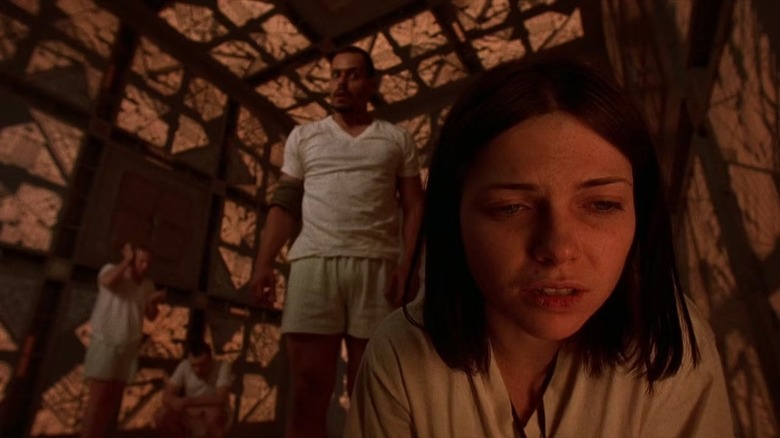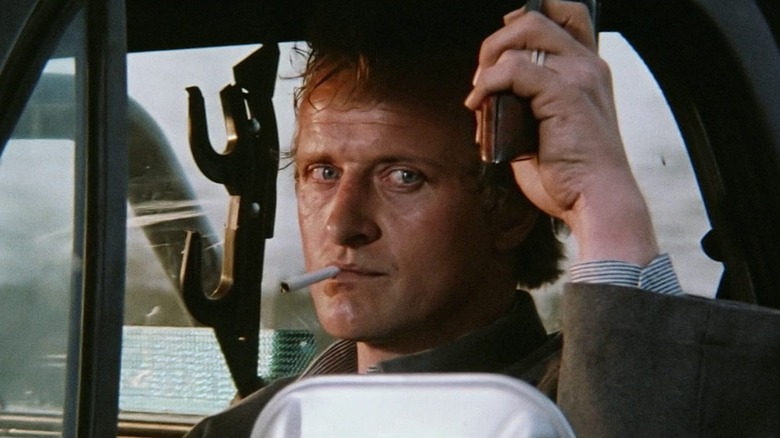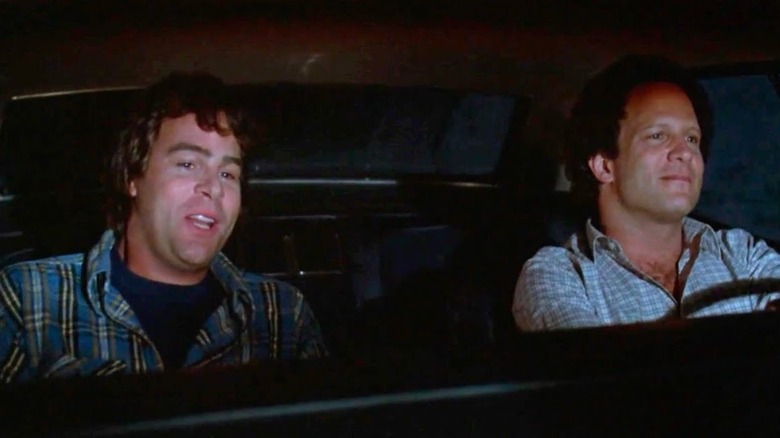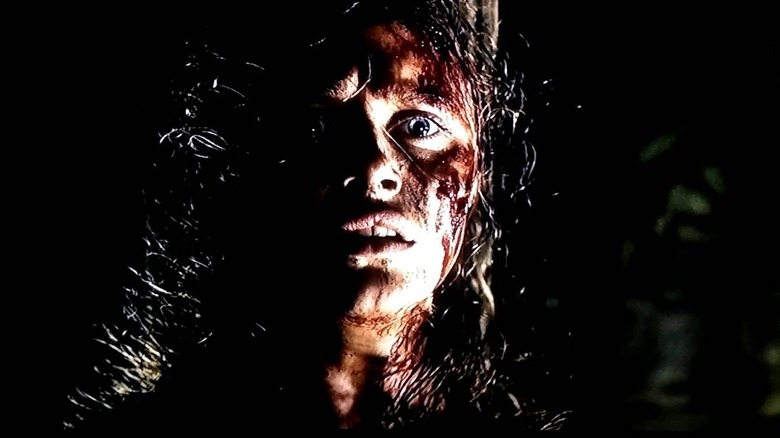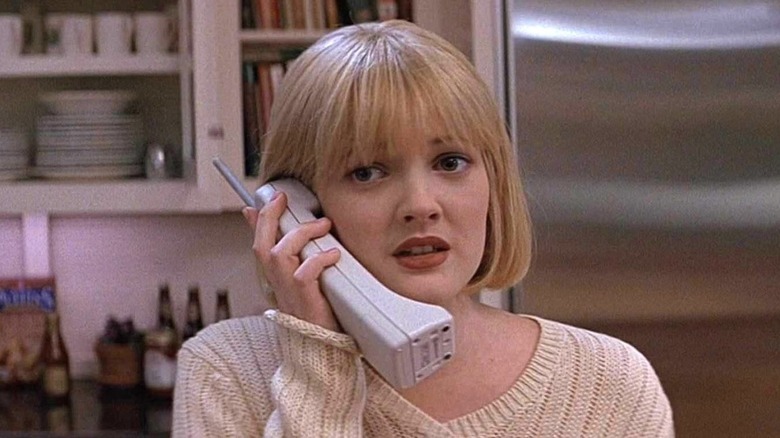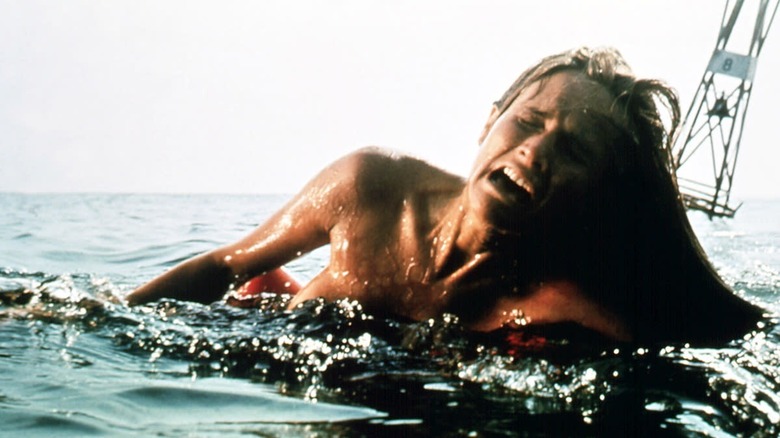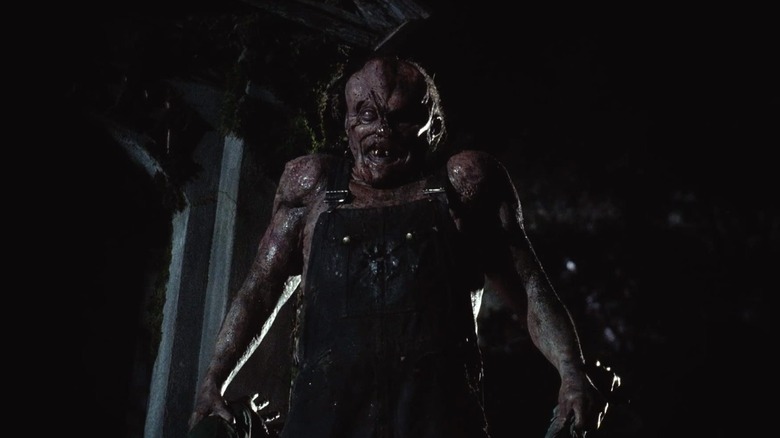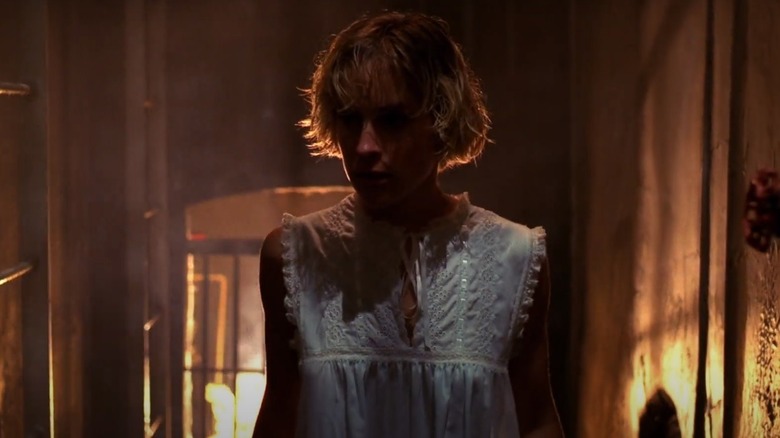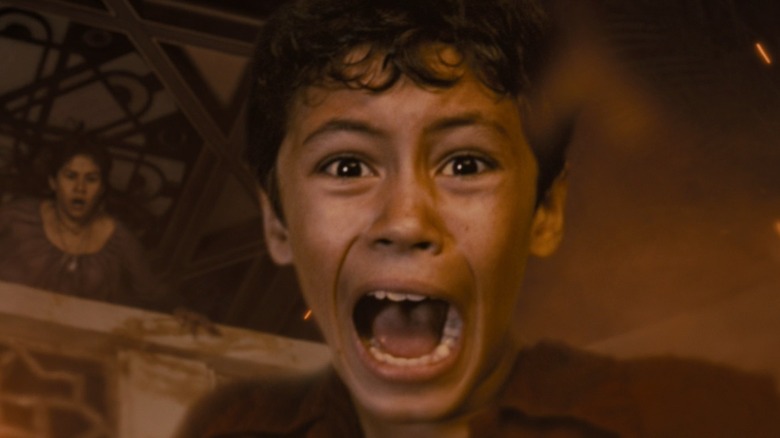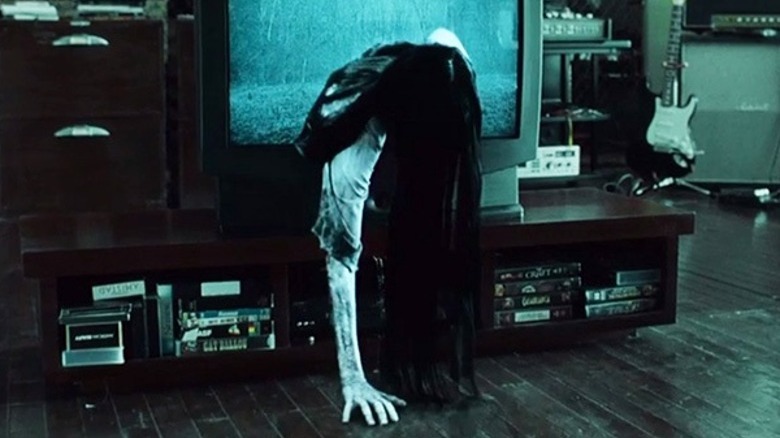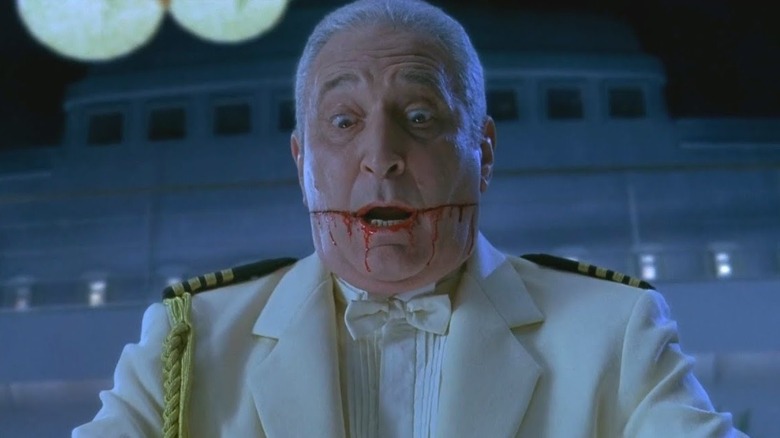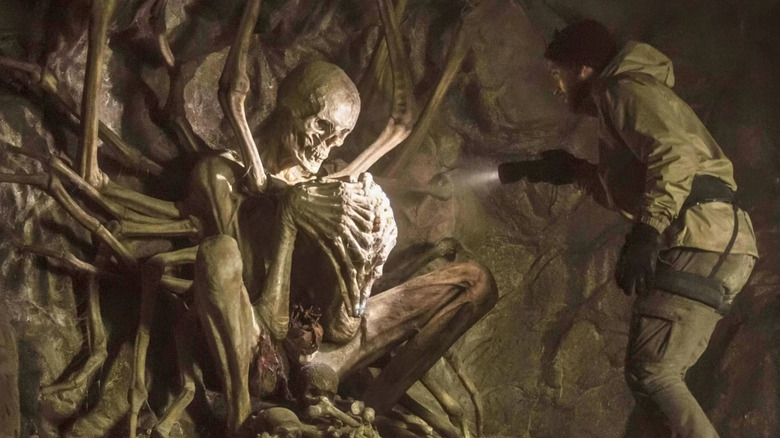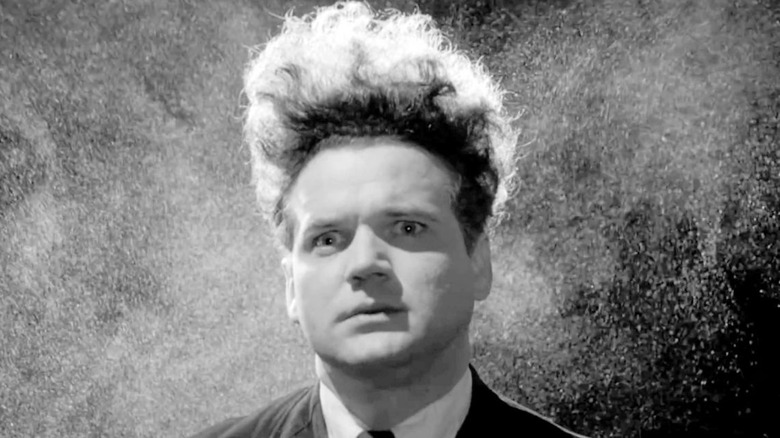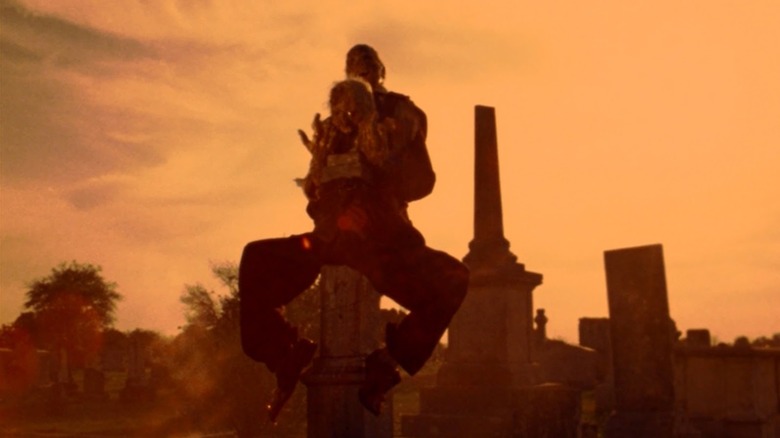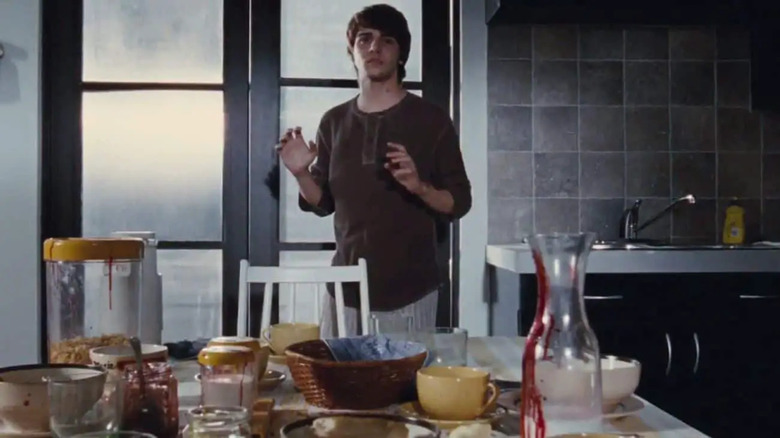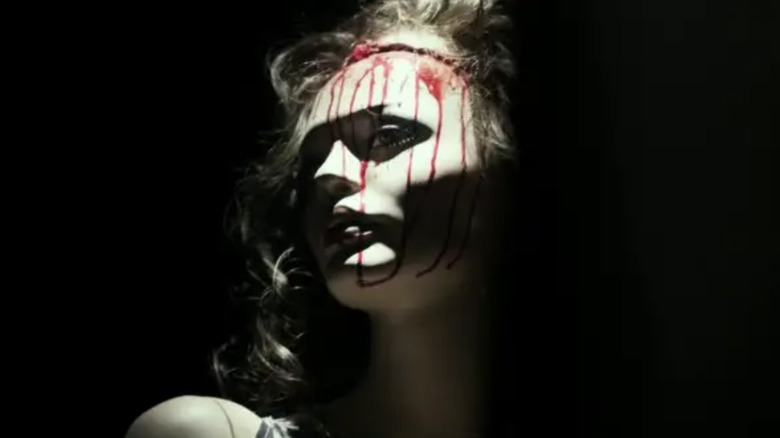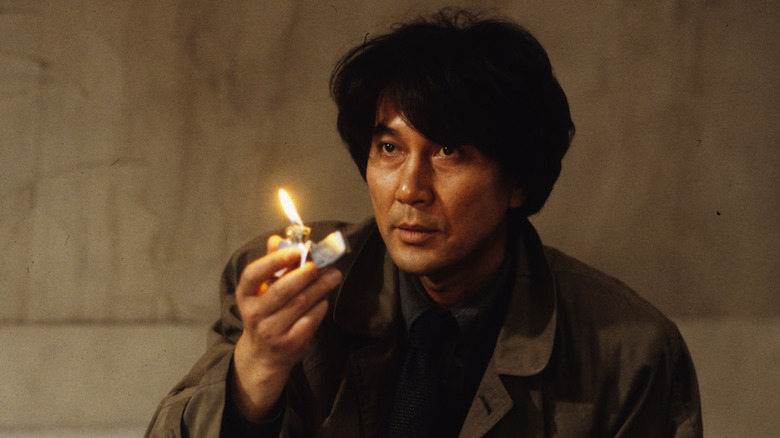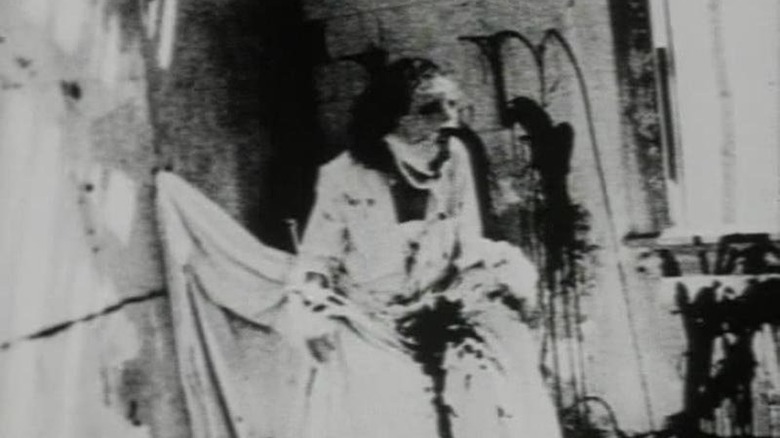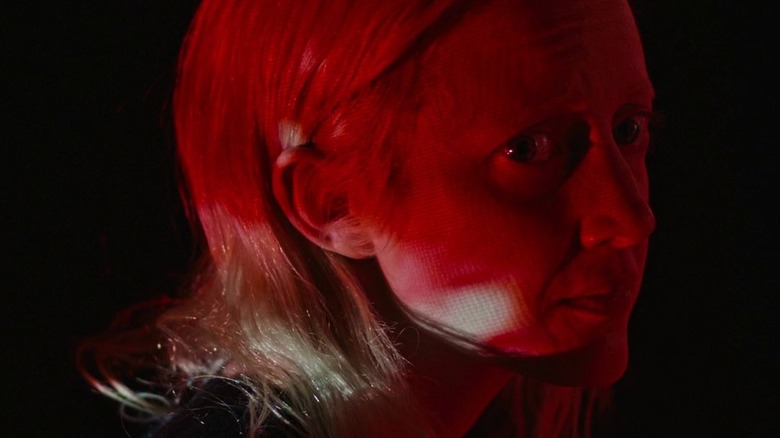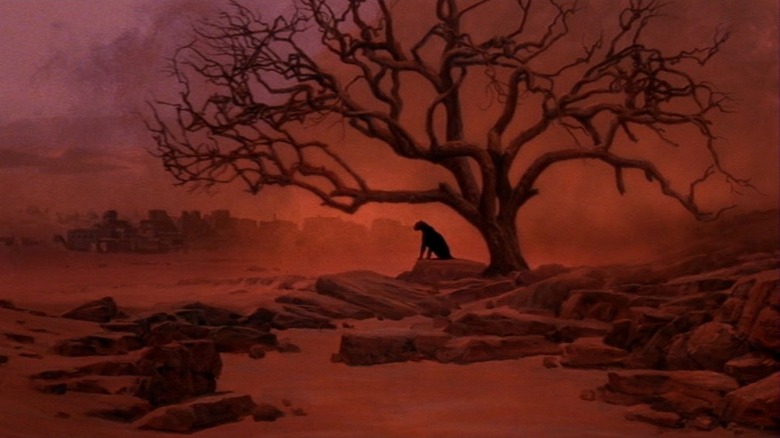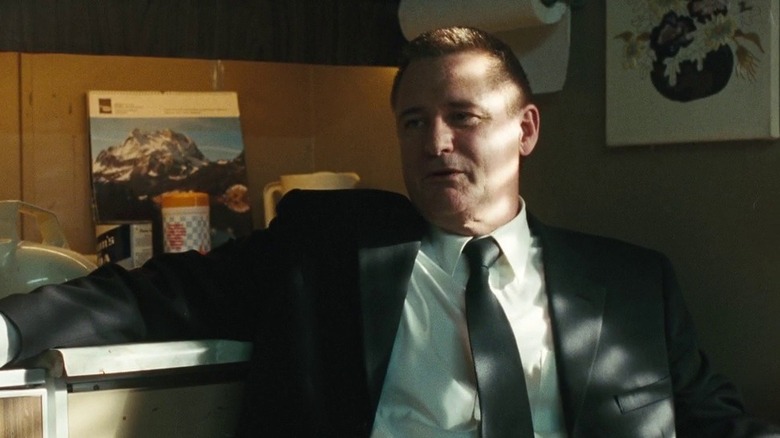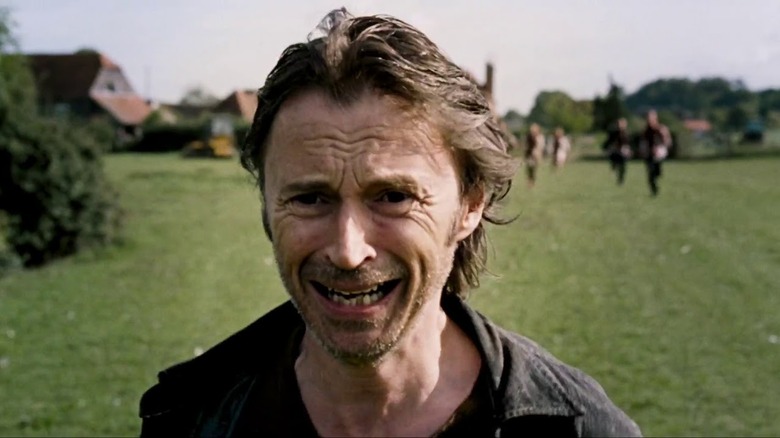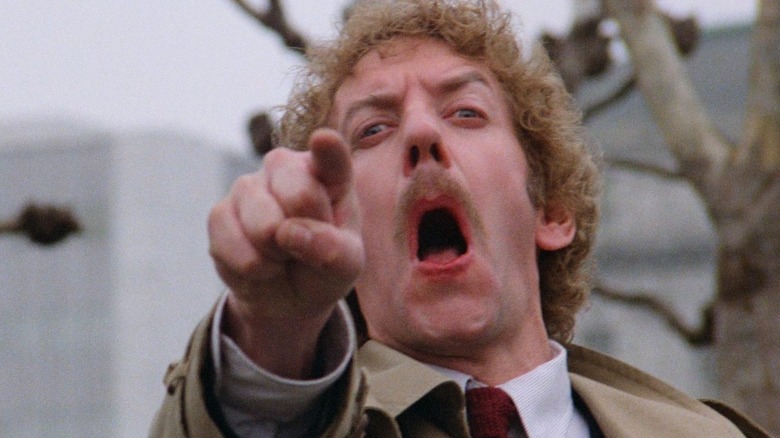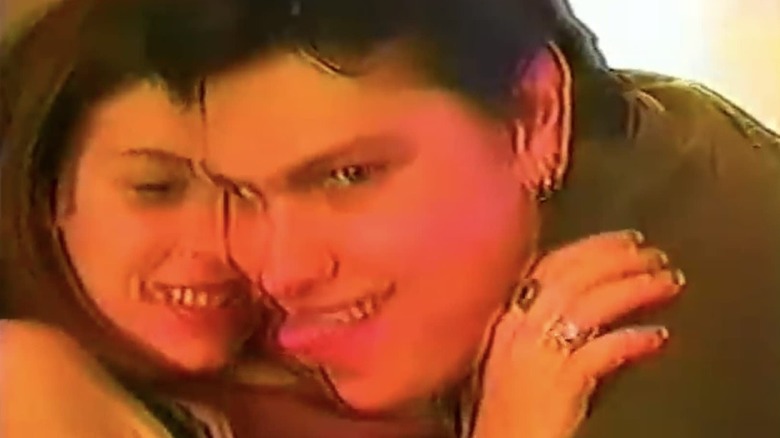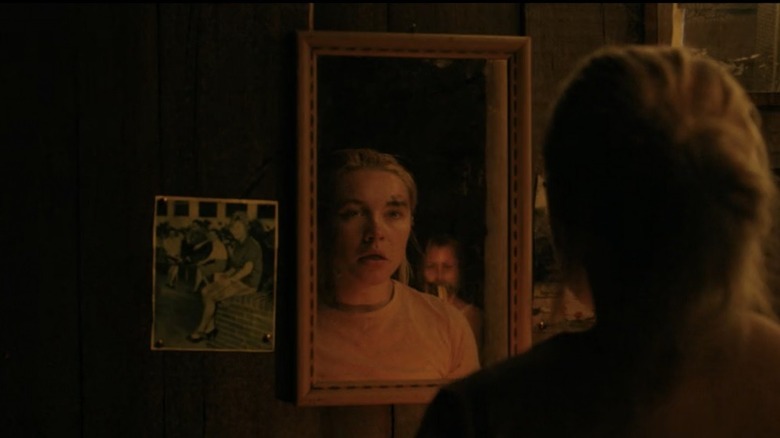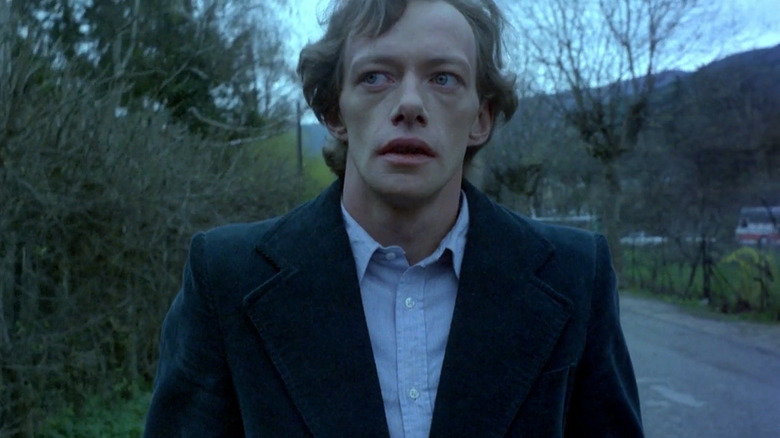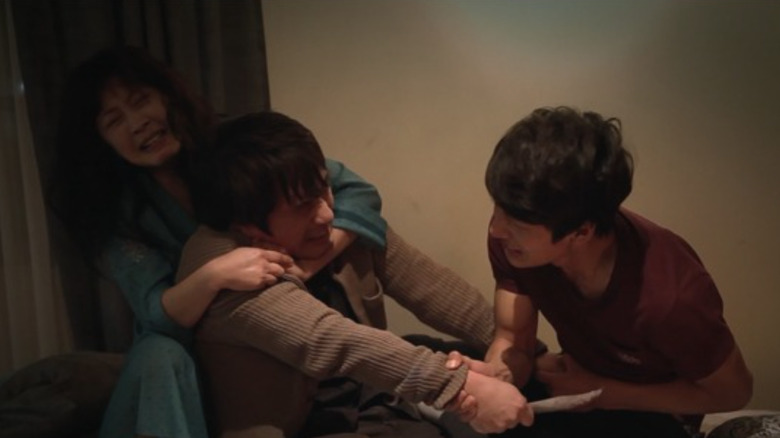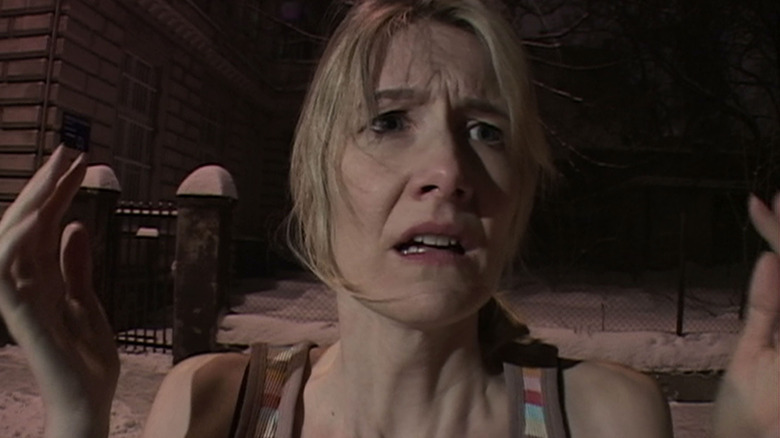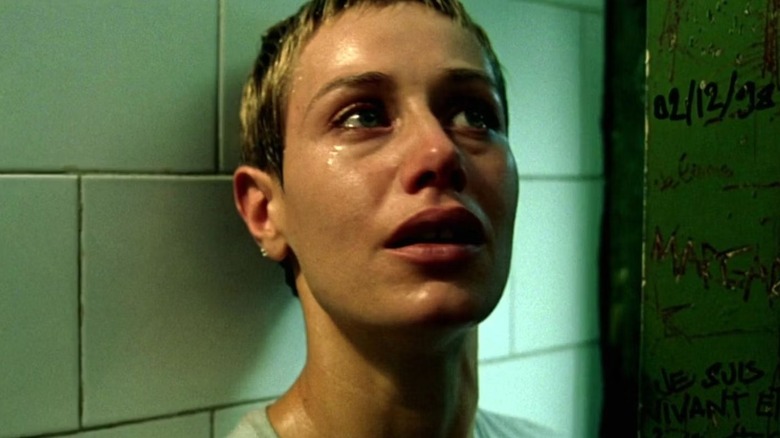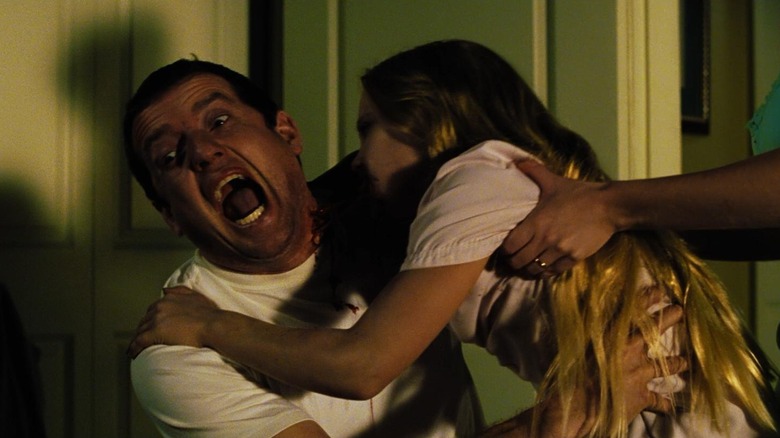The Most Terrifying Opening Scenes In Horror Films
Usually, the best horror film will have a slow burn. Modern classics like "Get Out," "You're Next," and "The Descent" earn their scares with gradually escalating tension, leading the audience carefully and deliberately into the dark, making their eventual payoffs all the more shocking. There's an undeniable craft to opening a fright flick with a semblance of normalcy, before slowly but surely lowering the viewer into the depths where the light is no longer visible, and there is only the nightmare.
These, however, are not those films. These are the ones that grab the viewer by the throat — in some cases, before the opening credits have even rolled — and let them know in the space of a few short minutes, and in no uncertain terms, what they've just signed up for. Many of them are among the scariest movies ever made, and every one of them boasts opening sequences that are certain to have the faint of heart nervously eyeing the exits. These are the most terrifying opening scenes ever put to film.
The following article includes descriptions of graphic violence and sexual assault. If you or anyone you know has been a victim of sexual assault, help is available. Visit the Rape, Abuse & Incest National Network website or contact RAINN's National Helpline at 1-800-656-HOPE (4673).
It Follows
"It Follows" was the breakout horror film hit of 2014, and everything about the film seems designed to keep the viewer permanently off-guard. Its deliberately vague production design, with elements cribbed from different time periods from the '50s to the modern day, was meant to leave the audience unsure of exactly when this film was supposed to be taking place, lending the proceedings a dreamlike quality. Its methodical pace mirrored that of its "monster," a painstakingly slow yet utterly relentless pursuer who could appear as anyone and could only be shaken off by passing the curse to another (through sex, of course). The film might have left the consequences of allowing "it" to finally catch up to you similarly vague, but writer/director David Robert Mitchell chose instead to spell them out with terrible clarity within its first three minutes.
In an opening that could serve as a terrifying vignette on its own, we follow an obviously traumatized young woman as she flees down a street to the beach — and something else is following as well. We don't know what it is yet, but we know she's scared to death, and by the end of the scene, we know it was for good reason. Some viewers may have been put off by the movie's ambiguous ending, but there was certainly nothing ambiguous about its opening, a 180-second master class in nerve-jangling terror.
Split
M. Night Shyamalan was heralded as the second coming of Alfred Hitchcock after his sterling 1999 hit "The Sixth Sense," but his filmography in the intervening years has been notoriously uneven. "The Visit" from 2015 was welcomed by many fans and critics as something of a return to form for Shyamalan, but he was saving his true resurgence for 2016's "Split," a wildly effective psychological thriller anchored by a career-high performance from James McAvoy as Kevin Crumb, a disturbed man with 23 different personalities — plus an additional one only known, quite rightfully, as the Beast.
The opening scene illustrates every teen's worst nightmare, as a trip to the mall for three teenage girls (Anya Taylor-Joy, Haley Lu Richardson, and Jessica Sula) turns suddenly and decisively perilous. The girls wait obliviously in the car for their accompanying parental figure to finish stowing packages in the trunk — but he won't be joining them, and their day takes a turn for the terrifying as Crumb nonchalantly takes his place in the driver's seat. Joy's face registers slowly dawning panic as she realizes what's happening, while the demeanor of McAvoy's Crumb goes from a ho-hum day at the office to sheer menace in the blink of an eye — the first ominous note of his masterful horror film performance.
Friday the 13th Part V: A New Beginning
The "Friday the 13th" series isn't exactly known so much for getting under the skin of viewers as it is for exposing everything under the skin of any teenager unfortunate enough to cross the machete-wielding path of Jason Voorhees, the wordlessly determined embodiment of violent doom (or, in the case of the first film, his equally determined and vengeful mother). Later installments leaned hard into funhouse territory, relying just as much on morbid humor as gory shocks — but not in the case of "Friday the 13th Part V: A New Beginning," a supremely underrated slasher which announces its intention to screw with audiences from the start.
Corey Feldman reprises his role as young Tommy Jarvis in the dream sequence that opens the film. On a dark, stormy night, Jarvis finds himself observing Jason's grave as two would-be grave robbers are digging it up. It doesn't go well, and Feldman's reactions, as he witnesses Jason rising once again to butcher the hapless crooks, sell Tommy's sheer panic and terror and set the stage for the most psychological of all the "Friday the 13th" films. Much has been made of the fact that "Part V" is the only installment to feature a copycat killer, which many viewers regarded as a copout. But its ridiculous body count, inventive kills and unnerving tone have earned it a place in the hearts of die-hard fans, and its brilliant opening is by far the best of the series.
IT (2017)
Stephen King's "IT" is widely regarded as being among the finest of his standalone novels, and its 1990 TV miniseries adaptation — featuring the great Tim Curry as the timeless, child-eating monster who lures in its prey by adopting the guise of Pennywise, the Dancing Clown — scared the pants off of many a '90s child while avoiding the novel's more graphic moments. The opening scene, in which young George Denbrough encounters Pennywise while looking for his paper boat in a storm drain, is familiar to many — which makes the version offered by Andres Muschietti's 2017 theatrical adaptation all the more impressive, as that familiarity robs the scene of exactly none of its near-unbearable tension.
That this is so comes down to one simple factor: Bill Skarsgard's borderline-feral, nerve-shreddingly terrifying performance as Pennywise. Much of the film's pre-release speculation centered on whether Skarsgard would be able to live up to Curry's classic turn, but that question was answered definitively within seconds of the appearance of those predatory eyes, floating in the darkness of the storm drain. Skarsgard famously unnerved everyone on set, Muschietti included, and it's easy to see why — plus, unlike the 1990 version, "IT" had no qualms about graphically portraying George's shockingly violent fate. It's an opening that would have been all too easy for Muschietti to stumble over — but instead, the home-run sequence established a vicious tone for one of the best horror films of the last decade.
Halloween
The late, beloved film critic Roger Ebert didn't mince words in his four-star review of John Carpenter's 1978 masterpiece: "I'd like to be clear about this," he said, "If you don't want to have a really terrifying experience, don't see 'Halloween.'" It's the film that gave birth to a thousand tropes, one that took merciless advantage of lighting, composition and foregrounds to scare the hell out of horror film audiences unaccustomed to being in the hands of a master filmmaker. It was a film unlike anything fans of fright flicks had ever seen — and that includes its virtuoso opening sequence, which put the viewer squarely in the shoes of a killer.
The voyeuristic camera work leads us through the halls of a suburban home, from the point of view of an as-yet unknown party who dons a clown mask, grabs a huge kitchen knife, and uses it to brutally murder a teenage girl in the midst of her preparations for Halloween night. The first-person point of view is only broken at the scene's end, when the girl's parents arrive home to find the murderer standing on their front lawn — revealed to be the victim's six-year old brother, Michael Myers, who would return home fifteen years later to finish what he started. Carpenter would go on to a long and distinguished career of scaring the living daylights out of audiences, which anyone brave enough to sit through the first six minutes of his breakout hit could have easily predicted.
The Stepfather (1987)
"The Stepfather" from 1987 boasted a novel premise: a straight-laced family man is actually a violent psychopath, only showing his true colors when his current family "disappoints" him; he then systematically slaughters them before assuming a new identity, moving on to another town, and finding a new family. Despite this, the film was a relatively by-the-numbers thriller that might have been consigned to the bargain bin of forgotten '80s horror films if not for one element — veteran character actor Terry O'Quinn, who blessed an otherwise workmanlike film with the performance of his career.
The film's opening brilliantly, and wordlessly, establishes its premise. We first see O'Quinn's character — calling himself Harry Morrison, although not for long — diligently scrubbing blood from his hands; it's obvious something terrible has happened, but Morrison doesn't appear to be too upset. He packs a few belongings, then strolls out of the house — past a scene of unimaginable carnage, a series of butchered bodies that we can tell from the framed photos on the walls are the remains of his family. Whistling a jaunty tune, he boards a ferry to go begin his new life as Jerry Blake — and when he marries into a new family, we are all too aware of the horrors that await once the "disappointments" begin. O'Quinn's performance made "The Stepfather" a cult classic, but he turned down the chance to reprise the role in the 2009 remake — which was, perhaps not coincidentally, panned.
Cube
"Cube," released in 1997, operated with a mind-bending sci-fi premise that revealed itself gradually after a stunningly effective cold open. A man awakens to find himself in a... well, cube-shaped room with several apparent points of exit, completely unaware of how he got there or what he is supposed to do. After finding all exits to be identical, if differently color-themed, he chooses... poorly.
The brilliance of the film's opening is in how it instantly imparts to the audience the disorientation and determination of this man whom we've just met — and then savagely (and literally) slices their expectations to ribbons. Viewers are left to parse out the predicament of the characters they'll come to meet right along with them, clues which the film methodically doles out along with shocking bursts of truly insane gore — but none of them blindside us quite so hard as the first, which not only boldly asserts the stakes of whatever game these poor people are playing, but serves as one of the absolute bloodiest opening moments in all of film.
The Hitcher (1986)
A young man picks up a hitchhiker by the side of the highway, in the middle of nowhere, on a dark and stormy night (another one of those). "My mother told me never to do this," he says, but the man is soaked to the bone, and at first he seems grateful for the lift, if not exactly forthcoming with answers to the young man's casual questions. But the encounter with the hitchhiker turns slowly more threatening; he claims to have run out of gas, but then says he doesn't need gas. Then, it turns out the car he had been stranded by wasn't even actually his. It belonged to the guy who picked him up last, but that unfortunate motorist won't be going anywhere anytime soon, because the hitchhiker "cut off his legs... and his arms... and his head. And," he says, "I'm gonna do the same to you."
Young Jim Halsey, played by C. Thomas Howell, will survive this encounter due to sheer luck, but the opening scene of "The Hitcher" introduces Rutger Hauer's John Ryder as an agent of pure mayhem, a man with no purpose other than random violence, and Hauer's performance makes his previous turn as psychotic replicant Roy Batty in "Blade Runner" look positively endearing by comparison. It's a film that tests the limits of its audience with brutally shocking gore, the wanton murder of women and children, and a truly disturbing ending — but, in all fairness, its sadistic bent is more than obvious from this first scene.
Twilight Zone: The Movie
"Twilight Zone: The Movie" from 1983 was noticeably short on true scares, save for director George Miller's harrowing reworking of the classic episode "Nightmare at 20,000 Feet," with John Lithgow ably filling the lead role occupied by William Shatner in the original. But its brief, pre-credits opening sequence has become the stuff of legend, and it added a phrase to the pop culture lexicon that still has the power to make our skin crawl: "You wanna see something really scary?"
Comedians Dan Aykroyd and Albert Brooks put the audience at ease as motorists on a lonely road at night, enjoying easy banter as they reminisce over old TV shows — including, of course, "The Twilight Zone." But when Brooks tries to rattle Aykroyd by turning off his headlights, Aykroyd ups the ante by insisting that Brooks pull over so that he can show him something even scarier — and boy, does he ever. The scene's end serves up one of the most merciless jump scares in film history. The sickening crunching and cracking of bones can be heard as the camera pans up to the sky, while original series regular Burgess Meredith begins to intone the familiar opening narration. The film's four main segments are rather hit-and-miss, but if you indeed wanna see something really scary, look no further than this brilliant opening scene.
Evil Dead (2013)
Horror film fans had plenty of reason to be wary of 2013's soft reboot of Sam Raimi's classic "Evil Dead." Recent attempts at reinventing the "Friday the 13th" and "Nightmare on Elm Street" franchises had fallen right on their faces, and recreating the tone of Sam Raimi's original "Evil Dead" would be difficult, if not impossible. But those fans had no way of knowing at the time that the project was in the hands of a major, as-yet unheralded talent: writer/director Fede Alvarez, who made no attempt to rehash what had worked in the previous series, but brought a wickedly inventive tone all his own instead.
The film opens with a terrified young woman being hunted down and captured in the woods by her own family, who appear to be religious fanatics bent on burning her alive. But as her father fumbles with the matches, the woman's tearful pleas take a hard left turn — and it suddenly becomes obvious that the only terrible mistake this family made was not getting that fire started a lot sooner. With one stunningly effective sequence, Alvarez let it be known that this "Evil Dead" would not be playing its premise for laughs, nor would it be pulling any punches. The best horror film of 2013 only disappointed fans in one respect — its lack of a sequel.
Scream
Wes Craven's 1996 deconstruction of the horror genre, "Scream" started a trend of self-awareness in fright flicks that continues to this day — but for all its willingness to point out and send up the genre's tropes, it's easy to forget what a virtuoso piece of filmmaking its opening sequence is. Drew Barrymore appears as a young woman named Casey, who receives what she thinks is a prank phone call from an unidentified party. As the guy quizzes her about horror movies, the tone of the call goes from playful to sinister to outright terrifying as Casey slowly realizes that this is no joke.
The scene plays with the well-worn trope of the mysterious caller who knows way more about the person on the receiving end of the call than he should — yet at the same time, Craven sets his audience up for a hell of a shock by putting Barrymore, the most famous actor in his cast, in the role of the doomed girl. It's an absolute master class in playing on audience expectations and building tension, and the final shot — as Casey's parents return home to a gruesome scene — is as disturbing as anything our imaginations could have conjured during the scene's buildup. The influence of "Scream" has towered over horror for the last couple of decades, but it may not have lingered quite as long in the popular imagination without this merciless attention-grabber of an opening.
Jaws
Much has been written about the prototypical summer blockbuster "Jaws," a film that was either going to make or break the career of its 26-year old director, Steven Spielberg. Virtually everything that could have gone wrong with the production did, up to and including the stubborn refusal of the mechanical sharks built for the film to cooperate — but the technical problems ended up enhancing the film in ways nobody could have foreseen, as Spielberg wisely chose to keep his toothy menace offscreen whenever possible and let John Williams' iconic score signify its presence.
Nowhere is this technique's effectiveness more evident than in the film's harrowing opening scene, as a young swimmer named Chrissy goes for the last moonlit skinny dip she'll ever take. For the actual attack, Spielberg and his crew employed an underwater system of ropes to jerk actress Susan Backlinie back and forth, and all we can see are her terrified reactions, which she completely sells. "Jaws" is a film that set the template for the summer tentpole picture and has been ripped off literally more times than can be counted — but its opening retains all of its power over four decades later, and as you may be aware, its young director went on to have a pretty good career.
Hatchet
When horror started to get bogged down in bloodless PG-13 affairs and found-footage flicks in the mid-'00s, writer/director Adam Green decided something needed to be done about it. That something was 2006's "Hatchet," an unabashed throwback to '80s slasher films featuring some of the most jaw-dropping practical gore effects seen since that era. The story is simple: a group of Mardi Gras revelers become stranded during a haunted swamp tour, where they're hunted down and dispatched by a vengeful undead monster. The film's effectiveness is in its execution — no pun intended — and the opening sets its tone perfectly.
A father-and-son pair of drunk hillbillies (the former played by none other than Robert Englund, sans Freddy Krueger makeup) are hunting for a huge alligator in the swamp at night. When the son disembarks from their canoe to relieve himself, the father falls silent — and the son quickly discovers that there are a lot worse things than alligators in this swamp. The scene keeps the audience off-balance by establishing a quirky, somewhat comic tone before veering hard left into shockingly explicit gore, and it loudly announces the filmmakers' intention to challenge the ability of even the most hardened horror fan to keep watching.
A Nightmare on Elm Street
Freddy Krueger is so iconic that sometimes we can forget just how scary he is. Throughout the sequels to 1984's "A Nightmare on Elm Street," Freddy becomes more and more verbose, prone to dropping ridiculous one-liners before dispatching his victims — but as originally conceived by horror maestro Wes Craven, there wasn't one damn thing funny about Freddy, and the disorienting opening of the original film establishes its villain as an otherworldly, terrifying bogeyman.
A young girl named Tina is in the middle of a nightmare, even if she (and we) don't know it yet. She's being pursued through a dark, noisy boiler room by a mysterious figure, one who appears to have knives for fingers... and we only get a decent look at him right before Tina wakes up screaming. Removed from the context of the increasingly cheesy series to follow, the dialogue-free scene is a perfect (and perfectly vague) introduction to the predator stalking Elm Street's children. It also cues the audience to expect frequent flights from reality, brilliantly establishing in just a few minutes that what we're seeing might not necessarily be real. The "Elm Street" series may have ended up providing laughs and scares in equal measure, but the original film had no intention other than to scare you silly, and its opening scene is truly a jolt of pure nightmare fuel.
Drag Me to Hell
After making three "Spider-Man" films in five years and failing to get a fourth off the ground, Sam Raimi was ready for a bit of a palate cleanser. This meant a triumphant return to gonzo horror with "Drag Me to Hell," the story of a loan officer named Christine (Alison Lohman) who runs afoul of an elderly woman by denying her an extension on her mortgage. Christine becomes the victim of a curse in which she'll be tormented by a demon for three days, at the end of which the foul spirit will — wait for it — drag her to hell. Christine is skeptical of her situation at first, but we're not, because we've seen the film's opening.
A young boy is brought to a medium by his parents after he steals a necklace from an old woman. The boy is convinced something evil is following him, and his parents think the medium can help. The boy is right; the parents are decidedly not. All of the old, "Evil Dead"-esque Raimi calling cards make their return: the off-kilter angles, the eye-popping closeups, the crazily kinetic camera work. But the scene also horrifyingly establishes that the film's unseen villain is one without mercy, as the boy's frantic pleas fail to head off his fate. "Drag Me to Hell" is imbued throughout with Raimi's signature dark comic touch, but its opening skimps on the comedy in favor of a heaping helping of darkness.
The Ring
2002's "The Ring" is the film that launched a hundred J-horror reboots, but this shouldn't be held against it. It's probably the very best horror film of its decade, even if its premise — a videotape that kills you seven days after you watch it — sounds supremely silly in elevator pitch form. Fortunately, the filmmakers realized this, and gave us an extended opening sequence which acknowledges it while masterfully toying with the expectations of the audience.
Teenagers Katie (Amber Tamblyn) and Becca (Rachael Bella) entertain themselves during a sleepover with the story of the cursed tape, which Katie claims to have seen. As she realizes it was seven days ago, she begins to choke — but she's just pulling Becca's leg, and they have a good laugh. Then, things start to get a little weird with the unexplained appearance of dirty water on the floor, a TV tuned to static won't turn off, Becca vanishes... and it becomes apparent that Katie really has seen the tape, and her seven days are up. The final shot before Katie screams in terror — of a television showing a black-and-white image of an old, decrepit well — somehow manages to be profoundly disturbing, even if we don't know why just yet. And if you watch very closely as the camera zooms in on Katie's screaming face, you can see it start to change — foreshadowing the film's most notorious jump scare.
Ghost Ship
"Ghost Ship" is, by all reasonable measures, not a very good film. Despite sporting a killer cast including Gabriel Byrne, Juliana Marguiles and Karl Urban, it suffered from problems in the writing, plotting and pacing departments; famed critic Richard Roeper bluntly called it "a dumb movie with dumb characters doing dumb things," which pretty much sums it up. But improbably, its opening scene has repeatedly been called among the greatest in the history of its genre, and with good reason — it's a doozy.
As the opening credits roll, we see a fancy ball taking place on the deck of a luxury ocean liner in the '60s; the scene is shot in soft focus, with sweeping big band music playing, and even the credits are rendered in a suitably elegant and classy font. Lovers stare dreamily into each others' eyes, a young girl gets a dance with the captain, and everything seems to be going smashingly — until an unseen assailant unspools a thin steel cable at a high rate of speed, causing it to snap and whip across the ballroom. For a sickeningly long moment, nobody is sure what happened... and then things start to fall apart, quite literally. It's the jarring juxtaposition of dreamy elegance with unthinkable carnage which makes the scene so brutally effective, and — the rest of the film notwithstanding — deserving of its place among the ranks of the greatest openings in all of horror.
The Empty Man
"The Empty Man," a supernatural horror mystery from 2020, is the feature-length debut of director David Prior, who was previously best known as a producer and director of behind-the-scenes featurettes. Prior used his first at-bat as an opportunity to tell a wildly original horror story that sprawls outwards in many directions. The culmination feels like a unique blend of the slasher, cult, and paranormal horror subgenres that mostly works but comes off as a little unwieldy. While mostly effective in what it sets out to do, "The Empty Man" perhaps bites off a bit more than it can chew. The plot gets a bit messy as it moves along, but the opening sequence is not hampered by this issue.
Before introducing the main character and the core plot, the film begins with an extended cold open that unfolds like a complete and compelling horror short film. In a remote location, a group of hikers meet their demise by way of a supernatural evil. The scene makes brilliant use of a whistle, possession, and a giant skeleton that unnerves through its bizarre anatomy. The opening scene ends up being one of the best ghost stories told in recent years and works perfectly well as a standalone tale in isolation from the rest of the film.
Eraserhead
1977's "Eraserhead" marked the debut of the one and only master of the surreal, David Lynch. In a career as experimental as his, it holds a lot of weight to say that his first feature-length offering remains the most experimental of his entire filmography. It follows Henry Spencer (Jack Nance) as he unexpectedly becomes the father of a seemingly inhuman baby.
The opening scene of "Eraserhead" immediately sets the film's oppressive tone and smothering atmosphere. Much of the film takes place in a surreal, industrial landscape, but the opening scene is set away from any identifiable setting. The intro presents the viewer with a barrage of unsettling visuals that are nearly impossible to understand or interpret upon first watch. The first shot is a double exposure of Henry's frightened face as he glides from side to side in front of something resembling an alien planet. Elsewhere, a disfigured man – credited as Man in the Planet — wrenches levers while a bizarre organism slithers its way out of Henry's mouth.
At face value, this opening scene might not seem like it has anything to do with the rest of the film. However, some Lynch fans point to the opening scene as being the key to understanding the entire movie, with the lever pulling representing sexual intercourse, and the organism exiting Henry and entering the planet representing conception. Of course, the nature of Lynch's abstract storytelling and his refusal to discuss his intentions means that his films are always open to numerous interpretations.
The Texas Chain Saw Massacre
Tobe Hooper's 1974 horror masterpiece kicked off a long-lasting legacy of sequels, remakes, prequels, and reboots, but none of the subsequent movies have ever held a candle to the original. Though sometimes unfairly written off as trashy and exploitative (it was outright banned in multiple countries around the world), "The Texas Chain Saw Massacre" is often hailed one of the best and one of the scariest horror films ever made. The scares kick off right away with the film's opening scene.
Given that the film was made on an extremely low budget, it makes sense that "The Texas Chain Saw Massacre" opens with a scene that is simplistic yet incredibly effective. The documentary-style narration provided by John Larroquette sets the stage for the violence and lends a sense of authenticity to the events that follow, which is compounded by the grungy realism of Hooper's visual aesthetic. The first shots of the film are glimpses of corpses in the flashes of a camera accompanied by one of the creepiest sound effects ever put into a horror film. The final visual of the opening scene is a grave-robbed amalgamation of corpses assembled together and impaled on the top of a pointy gravestone, sending chills into the viewer before a single living character has even graced the screen.
Martyrs
"Martyrs" is a 2008 French horror film from writer and director Pascal Laugier. This intense film was part of the New French Extremity movement, noted for its extreme violence and uncompromising gore. While some of the films from the movement could easily be classified as gratuitous and only aiming for shock value, plenty of others present effective tension and scares and have something more to say on a psychological level. "Martyrs" may well be the pinnacle of the entire movement.
The opening scene starts with a seemingly happy family having breakfast together. The film makes an unaware viewer believe that these people are going to be the main characters, but they don't live through the first scene. A stranger shows up at their door and violently guns them down one by one with a shotgun in gruesome fashion, including the teenage son and pre-teen daughter. The brutality of the shooting, its unexpected arrival, and the young ages of two of the victims all make the scene far more shocking and sobering than a normal movie gunfight. The shooter turns out to be the actual main character for the next stretch of the movie in a plot that is deceptively complex on a structural level and plays with the viewers' expectations at every turn. Do not make the mistake of accidentally watching the English-language remake from 2015 as it squanders everything that works about the original.
Maniac
2012's "Maniac" starring Elijah Wood is a remake of the 1980 horror film of the same name starring Joe Spinell. Both films tell the story of a deranged serial killer with a mannequin obsession and mommy issues who stalks the streets of New York City looking for women to scalp. What sets the remake apart and elevates it is French director Franck Khalfoun's decision to present the entire film from a first-person perspective.
The creative use of POV in "Maniac" makes the violence much more disturbing than it would be otherwise, and the film's opening scene capitalizes on its unique presentation style. Through the eyes of the killer, the audience watches as he finds, stalks, and closes in on his prey in painstaking detail. The level of realism is high, and Wood's heavy breathing as he sneaks up behind his unsuspecting target makes the scene unbearably uncomfortable even before the actual violence starts. When the time does finally come, the first-person POV showcases the kill in full, graphic detail without cutting away as he rams a knife up through her chin and then scalps her, all in one single gory shot.
Cure
1997's "Cure" is a Japanese horror film from acclaimed director Kiyoshi Kurosawa. The film stars Kurosawa's frequent leading man Kôji Yakusho as a detective investigating a string of bizarre and seemingly random murders carried out by different killers, though the victims all have gory Xs carved into them. However, before the detective protagonist is even introduced, "Cure" gets started by showing one of the murders as it unfolds.
The opening scene follows an unidentified man as he rips a pipe off a wall in a transit tunnel, has sex with a woman in a hotel room, then beats her to death wordlessly and without motive. The way the scene is shot makes the violence hard to watch as the entire pipe beating unfolds in one unbroken shot from a wide angle with a perfectly steady camera, lending a sense of fly-on-the-wall realism. What makes the scene even more disturbing, however, is that after the man kills her, he snaps out of a trance with no memory of what he just did. The broader plot revolves around a serial killer who uses hypnosis to force unsuspecting people to do the killing for him, so the man who actually carried out the pipe murder in the opening scene was just a normal, innocent person who was hypnotized into committing this terrible crime and had his life destroyed as a result.
Begotten
"Begotten" is a divisive underground horror film with a cult following from 1989. It is directed by E. Elias Merhige, who would go on to make a few more conventional movies later on in his career, including the excellent horror comedy "Shadow of the Vampire." That film is nothing like "Begotten," which is on the extreme end of the experimental spectrum. Though the film's avant-garde stylings have proven divisive, the presentation is undeniably unsettling.
The opening scene of "Begotten" has the power to serve as instant nightmare fuel for even the most hardcore horror fans. Grainy, high-contrast black-and-white footage shows an abstract depiction of a grotesque version of God committing suicide by repeatedly slashing at their stomach with a straight razor. The highly stylized visuals make it a bit difficult for the viewer to tell exactly what they are looking at, but that somehow only makes the whole thing even freakier. The minimalist sound design adds to the disturbing nature of the scene as it avoids music and instead pumps in natural ambiance and the quiet sounds of the body's rocking movements. This is one opening scene that effectively serves as a litmus test for the rest of the film as audiences will either be enthralled by its grotesque and experimental nature or want to jump ship immediately.
Possessor: Uncut
David Cronenberg, the man behind movies like "Videodrome" and "The Fly," has a well-earned reputation as the king of body horror. His son, Brandon Cronenberg, has proven that the apple doesn't fall far from the tree. The younger Cronenberg followed in his father's footsteps by making his own creative and gory horror films beginning with "Antiviral" in 2012 and following it up eight years later with "Possessor"
It is important to note that "Possessor" exists in two drastically different forms, a heavily censored version, and the completely uncensored "Possessor: Uncut," which received its own full release. The censored version scales back drastically on the film's sexuality as well as its violence and gore, which has a major impact on the overall effectiveness of the film, including in its opening scene.
"Possessor: Uncut" begins with a cold open scene that shows an assassination. Rather than a typical movie assassination, the kill is over-the-top violent with excessive graphic stabbing followed by a blood-gushing, suicide-by-cop ending for the assassin. After she dies, the assassin is revealed to have actually been an innocent person who was being possessed by the actual assassin, Tasya Vos (Andrea Riseborough), via sci-fi technology. The scene is gratuitously violent on a literal level but becomes more psychologically terrifying as the thought-provoking questions the film raises regarding free will sink in.
Cat People
"Cat People" started out as a subtle and restrained horror film made in the Hollywood studio system of the 1940s. When Paul Schrader decided to remake the film in 1982, the story was no longer constrained by the Hays Code of days past. Schrader and screenwriter Alan Ormsby took the premise of a woman who fears that sexual interaction will turn her into a giant cat from the original film and ratcheted everything up several notches.
From the very first scene of the movie, it's made clear that the '80s version of "Cat People" is a world apart from the original and that it's going to hold nothing back. The film begins in an otherworldly desert locale where red sand blowing in the wind unveils fields of skulls buried beneath the surface. A young woman is bound to a tree as a sacrifice to a panther. Except, instead of the panther mauling or eating her, it is implied that the panther impregnates her with a half-human, half-panther child. The film then jumps forward in time to show the mixed-species offspring being sent to breed with another panther all before the end of the intro sequence. Forced, ritualistic bestiality and cross-species offspring are taboo subjects that most horror films wouldn't dare touch upon, but Schrader's "Cat People" is a unique animal.
Surveillance
After her notorious directorial debut in 1993 with "Boxing Helena" resulted in widespread outrage, protests, and critical and commercial condemnation, director Jennifer Lynch went radio silent for the next 15 years. She made her long-awaited return with the far better received but still under-the-radar "Surveillance" in 2008. The film functions primarily as a thriller with strong horror and crime elements, with a plot that explores gristly serial killings in rural America.
Jennifer Lynch is the daughter of director David Lynch, and she takes some cues from his films here. Her father served as the executive producer and performed the song that plays over the credits. His influence can be felt throughout the film, especially in the opening scene.
While the bulk of "Surveillance" is relatively conventional in its presentation, the introductory sequence is experimental and extremely effective. The scene tracks a victim's attempted escape from her deranged captors and eventual killers. On paper, the scene might not be anything all that special, but the presentation makes it downright terrifying. The intro utilizes streaky slow-motion and choppy editing, and the sounds of the victim's scream are distorted and stretched in a way that is bound to get under the viewer's skin. It sets a creepy atmosphere for the film, which lingers quietly in the background until erupting back to the forefront in the wild third act.
28 Weeks Later
Rather than checking back in with Jim, Selena, or Hannah from British zombie masterpiece "28 Days Later," the sequel, "28 Weeks Later," wipes the storytelling slate clean and only carries over the rage-infected England setting of the first movie. A narrative reset like that for a sequel puts a lot of weight on the opening scene. Luckily, "28 Weeks Later" rose to the challenge with its intro, even if the film comes up short when compared to the original in other areas.
In what is probably the peak of the film, the opening sequence concisely introduces a new group of survivors living out the zombie apocalypse in an isolated cottage. Audiences begin to get to know the survivors individually, but the zombies bust in and tear them apart before the end of the intro. With character development, world-building, action, and gore, the opening sequence of "28 Weeks Later" feels like a strong zombie short film all on its own. The hard-hitting soundtrack also adds a lot to the scene, especially as lone survivor Don (Robert Carlyle) sprints across a field with zombies hot on his tail.
While the sequence works great in isolation, it also sets the rest of the film's plot in motion. Don's decision to choose self preservation and abandon his wife instead of trying to save her leads to him reconnecting with his children in the militarized London. His shocking split second decision comes back to bite him when his wife turns out to be a survivor and asymptomatic carrier of the rage virus.
Invasion of the Body Snatchers
"Invasion of the Body Snatchers" is a classic sci-fi horror film from 1956, based on Jack Finney's novel "The Body Snatchers." The 1978 remake was able to push the horror elements much further because of advancements in special effects and the fact that the Hollywood Production Code had been repealed in the intervening years. Just like the previous incarnation, Philip Kaufman's version of "Invasion of the Body Snatchers" tells the story of alien copies secretly taking the place of real human beings. The remake swaps the small-town locale of the original for an urban San Francisco setting, injects a strong dose of body horror via the alien transformations, and delves into greater detail regarding the aliens' replication process and how they arrived on Earth.
Rather than starting out in any sort of humanoid form, the alien entity first arrives as a difficult-to-describe biological material somewhere between seed, water, and smoke. The opening scene tracks the journey of this alien substance from its planet of origin all the way down into Earth's atmosphere, where it becomes lost in the rain. There is something truly terrifying about just how easy it is for this alien substance to reach the planet and spread throughout the population without anyone noticing, similar to how a real-world virus is communicated from person to person invisibly. The knowledge that it may already be too late by the time the human characters notice makes the alien substance's arrival chilling from the get-go.
August Underground
After the incredible box office success of 1999's "The Blair Witch Project," the found footage horror subgenre underwent a major boom. Dozens of copycats and imitators were made to try to capitalize on that success. One imitator that never hit the mainstream but found a cult following is 2001's "August Underground" from Fred Vogel, the head of the proudly depraved Toetag Pictures. The film was successful enough to spawn two sequels in the form of "August Underground's Mordum" and "August Underground's Penance" and launch the Toetag Pictures production company.
Setting aside any of the artistic or basic storytelling ambitions of "The Blair Witch Project," "August Underground" only concerns itself with being as gory and shocking as possible. It presents itself as real found footage and masquerades as a genuine snuff film. Though it is 100% fake, the film can be extremely convincing in its unflinching and realistic portrayal of violence and gore thanks in part to its grainy visual aesthetic. Before the opening scene is over, viewers will have already been subjected to footage of a nude woman bound to a chair and being tortured by two sickos. Alongside all the standard horror violence, there is also sexual assault, excrement, and nipple slicing in the opening minutes. There is no story, film craft, or entertainment value to be found in "August Underground" for anyone but the most hardcore gore hounds.
Midsommar
Writer and director Ari Aster followed up his excellent debut feature film "Hereditary" with another strong horror outing in the form of 2019's "Midsommar." The story mostly revolves around a group of naïve Americans who head to an isolated Swedish village for a festival that only happens once every 90 years. The festival, of course, turns out to be much darker than they expected and a terrible fate befalls them all. Before the festivities get underway, the film starts out much closer to home for Dani (Florence Pugh).
The opening of "Midsommar" is perhaps the most disturbing scene in the entire film. It is also heartbreaking and tragic. While Dani is away from home, her depressed sister ends her life via car exhaust, which also kills both of their parents by asphyxiation. This intro sequence isn't really a traditional horror movie scare but the slow zoom on the sister's lifeless body sticks with you and the emotional trauma it unleashes on Dani is terrifying on a deep level. With the opening scene being such a gut punch, it is hard for the rest of "Midsommar" to live up to it. Even as the violence, bloodshed, and fire are unleashed in the film's final act, many viewers will still be left thinking that the movie peaked with its opening scene.
Angst
1983's "Angst" has a notorious reputation for many reasons. The film is shockingly violent and seemed to come out of nowhere, with a first-time director bringing an obscure true story of a psychopathic murderer to the big screen. The director, Gerald Kargl, never made another movie, further cementing the film's mysterious aura. For many years, "Angst" was extremely difficult to watch as it was banned in many countries and wasn't officially available in the U.S. until relatively recently with a physical media release in 2015.
With a unique up-close and constantly-moving camera, the film tracks the protagonist's murderous activities in excruciating detail. The opening scene of the film follows the unnamed killer — played nearly silently by "Das Boot" star Erwin Leder — as he goes on the prowl for a person to kill. The randomness of his victim selection makes his eventual act of violence far more terrifying than if he'd had a specific target in mind. With little rhyme nor reason in his methodology, the killer makes his way down a quiet suburban street with a gun in his hand in broad daylight. After tugging on a couple of locked doors and fences, he eventually finds himself at the front door of a home that is opened by an elderly woman, whom he shoots and kills instantly without any reason or motive. The scene feels chillingly real, making it clear to the viewer that something like this could happen to anyone.
Moebius
"Moebius" is a seldom seen but incredibly disturbing horror film from South Korean filmmaker Kim Ki-duk. Just as with some of Kim Ki-duk's other films, "Moebius" features virtually no dialogue and tells its story visually. This film doesn't need words to be disturbing, and the silent opening sequence gets it started in sickening fashion.
After she discovers her husband is cheating on her, a wife/mother loses her mind and is driven to commit obscene and terrifying acts. By the end of the first couple of minutes of "Moebius," the mother has already tried to have sex with her son. When he rebuffs her, she cuts his penis off with a knife. As if that wasn't gross and intense enough, she then eats his severed penis and tries to bite her husband's fingers off. This opening scene makes it clear that there is no line that "Moebius" won't cross and that no subject is too taboo. When this shocking whirlwind of an opening sequence is over, the film slows down a bit but remains just as uncomfortable and uniquely disturbing. "Moebius" is a messed-up flick that will shock even the most desensitized horror fans.
Inland Empire
After being nominated for best director at the Oscars and for the Palme d'Or at the Cannes Film Festival for his 2001 film "Mulholland Drive," David Lynch took a five-year break from feature filmmaking, though he continued making shorts and music videos during that time. When he returned to films, Lynch went back to his roots with "Inland Empire" to deliver his most bizarre and fully experimental work since his feature length debut, "Eraserhead."
"Inland Empire" is three hours long, cryptic, shot on ugly, low-resolution digital video, and, most importantly, absolutely terrifying. Lynch holds nothing back and opens the film with a purely experimental sequence that does not seem to have anything to do with the rest of the film on face value. Shot in stark black and white, the double-exposure photography makes the mixture of images hard to interpret. The simple visual of a needle scratching along a record feels intense and threatening the way Lynch presents it, with off-kilter extreme close-ups, heightened sound design, and superimposed images of what might be the inside of a human body or something else entirely.
The opening scene progresses directly from the strangely hypnotic record needle imagery to a hotel where a man and woman converse with unsubtitled dialogue in an unidentified language. Their actions aren't all that out of the ordinary, but their faces are blurred beyond recognition in a manner that is unsettling in a nebulous way. The intro is strange and frightening in equal measure, which sets the tone and atmosphere of the film that follows perfectly.
High Tension
2003's "High Tension" is the second feature film directed by Alexandre Aja, who went on to direct much more mainstream horror films like the 2006 remake of "The Hills Have Eyes" and 2010's "Piranha 3D." Aja's second directorial effort was an early example of New French Extremity and one of the defining films of the movement. The basic plot is just about as straightforward as you can get in the horror genre: A nameless killer with a razor bursts into a cottage to slaughter the family inside, and a tense, blood-soaked cat-and-mouse game follows.
What makes the bare-bones plot work for the majority of the runtime is Aja's slick, grounded direction and his unflinching portrayal of extreme violence. The kills in "High Tension" are all ratcheted up high enough to feel fresh and shocking within a genre that is prone to desensitizing fans. The film's opening scene sets the tone and lets you know that "High Tension" aims to shock and disgust. Within the opening moments of the film, the killer is shown having sex with a woman's severed head, setting the bar for the level of depravity that the rest of the film will indulge in. The film's nonsensical twist ending throws the opening scene and much of the plot into question, but that doesn't change the impact it has upon first watch.
Dawn of the Dead
George A. Romero followed up his genre-defining 1968 zombie film "Night of the Living Dead" with the equally revolutionary "Dawn of the Dead" exactly one decade later. In 2004, "Dawn of the Dead" was remade by Zack Snyder as his feature film debut, after having made a name for himself as a director of music videos. While Romero's original version is the vastly superior film overall, Snyder's remake does boast one hell of an opening sequence.
The intro sequence begins by showing the relatable day-to-day routine of Ana (Sarah Polley). Wasting no time at all, the film then rapidly shifts gears with an intense and bloody encounter involving a zombified child. It comes out of nowhere, and it sends chills down the spine. The film then widens its scope to briefly showcase the start of the zombie apocalypse.
Giving a perspective on the very start of the zombie takeover is an element that is unique to Snyder's remake, while the rest of the film utilizes the same shopping mall setting as Romero's original. "Dawn of the Dead" never manages to quite live up to the high bar set by the terrifying opening sequence, but it remains an entertaining zombie flick that stands out well enough from the sea of zombie movies that came out in the 2000s.
